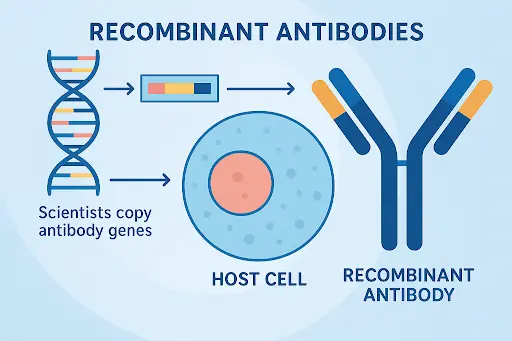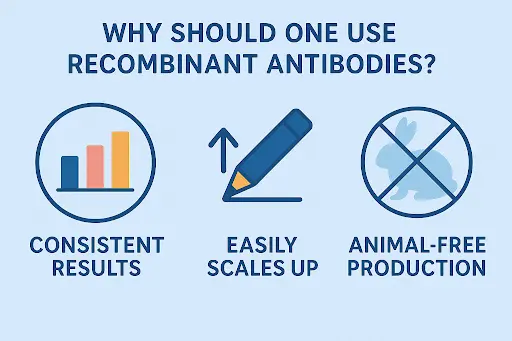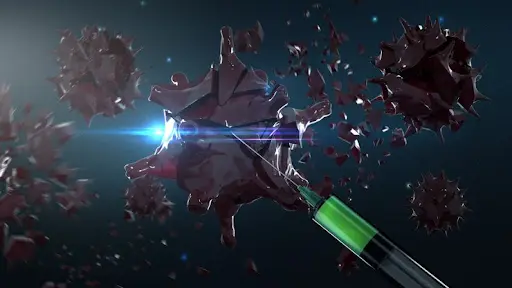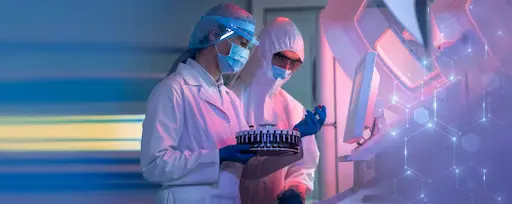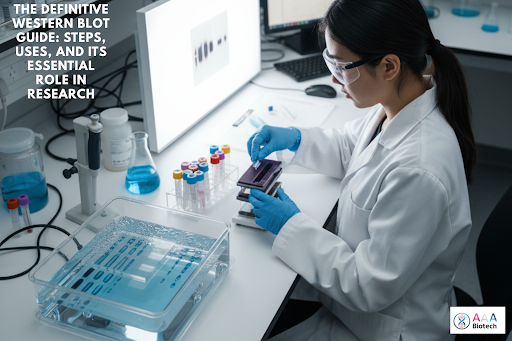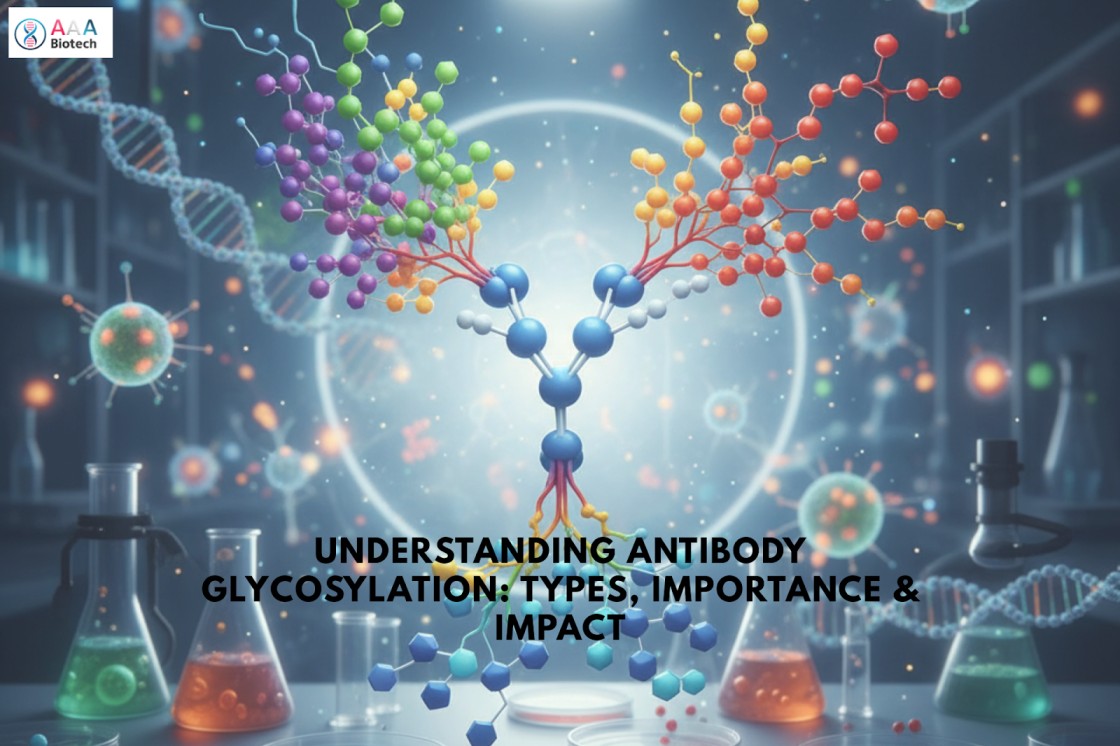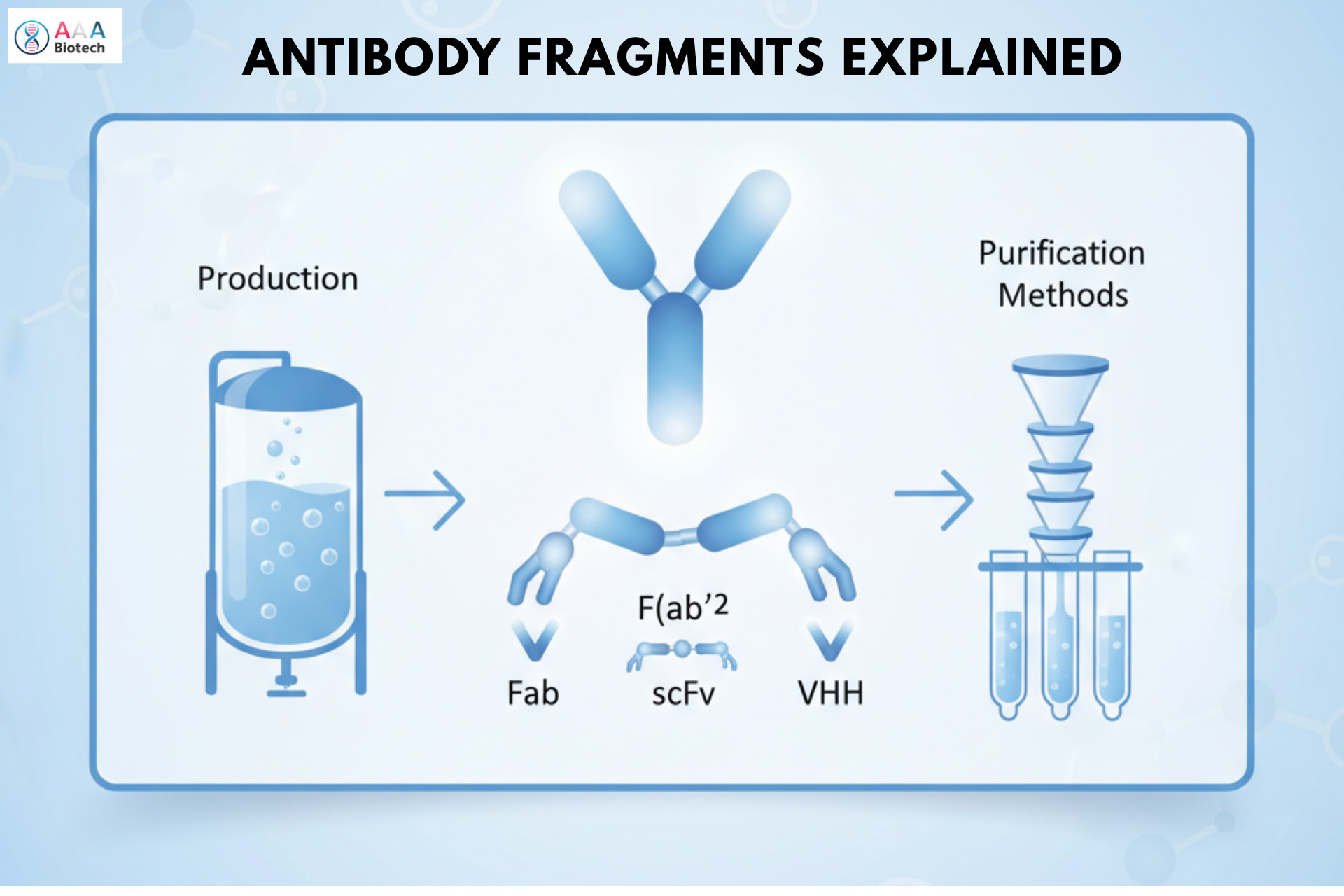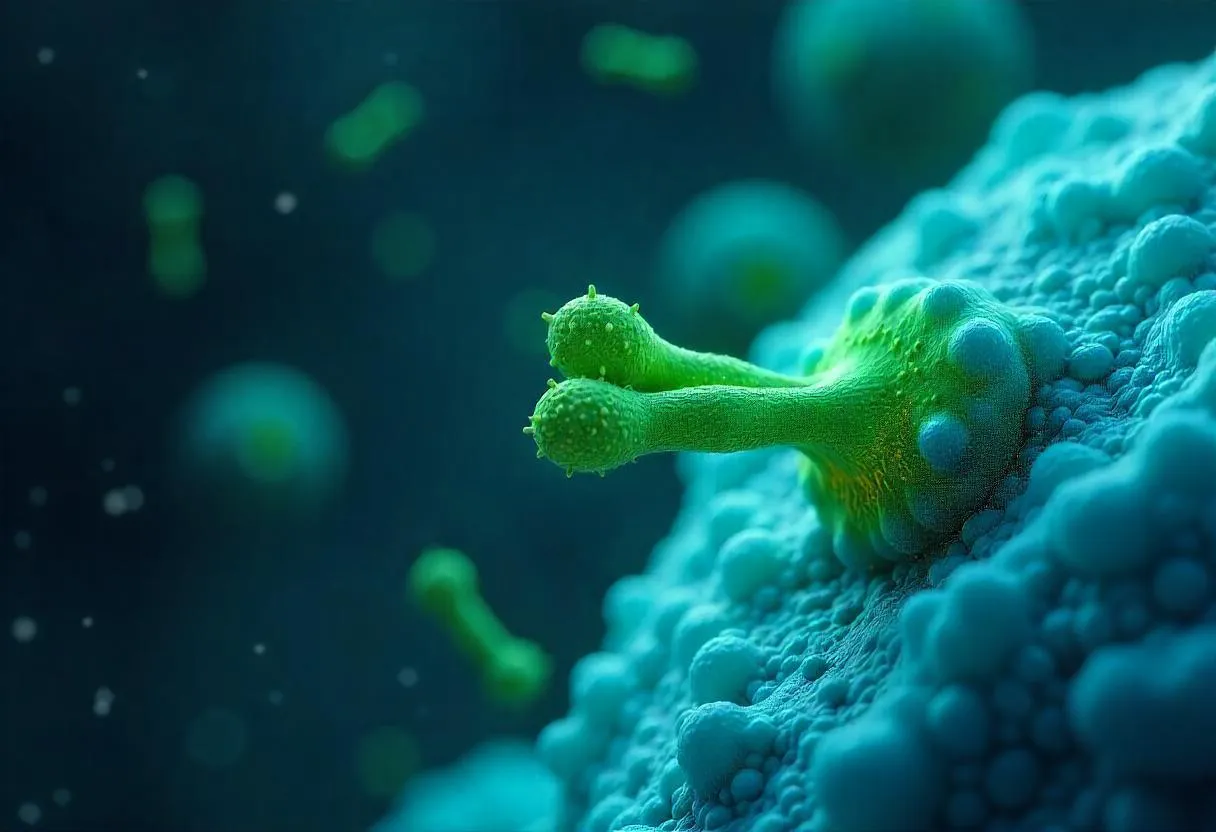Recombinant Antibody Overview: Production & Applications
In this Article
All of the products listed in AAA Biotech’s catalog are strictly for research-use only (RUO).

An Overview
- Recombinant antibodies are lab-made alternatives to traditional monoclonal antibodies. No animals are used in their production.
- Allow for high batch-to-batch consistency, scalability, and customization.
- Ideal for research and diagnostics.
- Types of recombinant antibodies include chimeric antibodies and smaller fragments like scFv, Fab, and VHH.
- These antibodies are engineered for better tissue penetration. There will be shorter half-life and lower immune response risk.
- Production methods use genetic engineering — cloning antibody genes,
inserting them into host cells, and screening using display technologies.
To Begin, What Are Recombinant Antibodies?
These antibodies are a lab-made version of monoclonal antibodies. Instead of using animals to produce them, scientists copy the genes for the antibody and insert them into special host cells (usually mammalian cells).
These cells then produce the antibody in a controlled lab environment. Other host types, like bacteria, yeast, or insect cells, can also be used.
Why Should One Use Recombinant Antibodies?
Consistent Results
Since the exact identical genetic code for the antibody is known and used every time, recombinant antibodies are very consistent from batch to batch.
Traditional methods, such as hybridomas, can lose stability with time. It has been known to cause changes in the antibody’s behavior.
Easily Scales Up
Recombinant antibodies are made using lab-based methods that can be easily scaled up for larger studies. Since the sequence is saved digitally, the same antibody can be reproduced as needed, even years later.
Easy to Modify
Knowing the full sequence of the antibody makes it easier for customization by scientists. For example:
- Switching the antibody type (isotype-switching)
- Changing the “species” it is recognized as originating from (species-switching)
These changes are helpful in experiments that require multiple antibodies to
work together without cross-reactions.
Animal-Free Production
Traditional methods used to rely on living animals, while recombinant antibody production is animal-free. The antibodies are purified from lab-grown cell cultures, making the process more ethical and easier to control.
Types of Recombinant Antibodies
Chimeric Antibodies
These are one of the earliest types of recombinant antibodies developed. Their development came as a result of the need to solve a problem observed in antibody therapy.
Such as, when mouse-derived antibodies were given to humans, the human immune system often saw them as “foreign” and reacted against them.
To reduce this immune response, scientists in 1984 created chimeric antibodies. These were produced by combining mouse and human antibody sequences using genetic engineering. These antibodies typically contain:
- 30–35% mouse antibody
- 65–70% human antibody
The combination allows the antibody to keep its original target-binding ability
(from the mouse) while making it more “acceptable” to the human immune system.
Replacing parts of the animal antibody with those of the human antibody, is what
is referred to as “humanizing” the antibody.
Creating chimeric antibodies is often the first step in developing humanized antibodies for therapeutic use. Advanced tools like computer modeling and region grafting techniques help increase the chances of success in this process.
Antibody Fragments
A full-sized antibody (like IgG) is made up of two light chains and two heavy chains, connected by special chemical bonds. Scientists have developed smaller versions of antibodies, referred to as antibody fragments, such as:
- scFv (single-chain variable fragment)
- Fab
- VHH (also known as nanobodies)
Because they are smaller in size, these fragments can:
- Enter tissues or tumors more easily than full-length antibodies
- Be used in imaging studies thanks to their shorter half-life, which means they stay in the body for a shorter time
These qualities make them promising tools for research in immunotherapy,
especially for solid tumors.
How Are Antibody Fragments Made?
Originally, antibody fragments were created by using enzymes to cut full-size IgG antibodies:
- Pepsin cuts the antibody to make an F(ab')₂ fragment
- Papain can then further split it into two individual Fab fragments
However, this enzymatic method has limited utility and is not ideal
for large-scale production.
Thanks to advances in antibody engineering, scientists can now produce these fragments recombinantly:
- After cloning and sequencing the antibody genes, the fragments can be made in controllable lab environments such as in HEK293 cell culture
- This method allows for more precise, scalable, and reliable production
High-Throughput VHH Production
With growing expertise in recombinant technology, platforms now exist that allow
high-throughput production of antibody fragments like VHHs.
For example, specialized expression systems can achieve over 90% success rates in producing these fragments for research.
What Are Its Applications?
Recombinant antibodies (rAbs) offer unique advantages that make them suitable for specific research needs. Some scenarios below are provided as examples:
- When a short time in the bloodstream is needed (the antibody doesn’t stay in the body for long).
- When a smaller antibody is needed to diffuse more easily through tissues or to penetrate into tumors.
- When the antibody needs to be made in yeast or bacteria (E. coli) to lower costs or to make large amounts more easily.
- When the antibody is designed without the Fc component, so it doesn’t trigger host immune cells or cause receptors to clump together.
- When a bispecific antibody fragment is needed — meaning it can attach to two different targets at once, like BiTEs (bispecific T cell engagers), diabodies, or DARTs.
- When the antibody needs to be made in yeast or bacteria (E. coli) to lower costs or produce more, and also without the Fc component to avoid host immune reactions and receptor clumping.
How Are Recombinant Antibodies Made?
Gene Cloning
Every antibody is made of two main components:
- A heavy chain (VH)
- A light chain (VL)
Production scientists start by using a method called PCR (polymerase chain
reaction) to copy the genes for these chains.
To accomplish this, they design special short pieces of DNA called primers to help copy the target sections.
Once the VH and VL genes are copied and purified, they are inserted into a plasmid. A plasmid is a small circular DNA molecule that is utilized used as a “gene carrier”. This plasmid is what is utilized to enable the genes to enter and work inside the intended host cells.
If you're creating a special type of antibody fragment called scFv, a linker must be added between VH and VL to keep them linked as one single unit.
Transformation into Host Cells
Next, the engineered DNA (with VH and VL genes) is inserted into host cells, usually bacteria or other lab-friendly organisms.
It is performed using a method called electroporation, which involved using an electrical pulse to disrupt the cell membrane briefly and allow the DNA to enter.
Using highly competent cells (cells that take up DNA efficiently) is crucial for obtaining good results.
Display and Selection
After the host cells start producing antibody fragments, scientists can screen and choose the best ones.
Screening techniques find the antibody fragments that bind strongly to the target.
Some popular display methods include:
- Phage display: Utilizes viruses (phages) to show antibody fragments. It is helpful in creating large libraries of different antibodies.
- Ribosome display: Creates massive antibody libraries without needing cells at all. It is useful for finding rare or mutated versions.
- Yeast display: It uses yeast cells, which are closer to human cells in how they process proteins. It becomes ideal for expressing human-like antibodies.
To Wrap Up
Recombinant antibodies are becoming popular with many scientists because they
are very consistent, sensitive, and easy to test. They can be used in many ways,
making them great for research, disease testing, and medical treatments.
These antibodies can also help make antibody-based medicines cheaper and perform their intended purpose better.
Because they can be specially designed and customized, they can reach deep into tissues or carry medicines directly to specific cells. It gives researchers many new and different ways to use them, and opens up wide ranges of possibilities for further therapeutic development and innovation.
Faq's
How Are Recombinant Antibodies Made?
Recombinant antibodies are made by inserting the genes for the antibody’s heavy and light chains into one or two small circular DNA molecules referred to as plasmids. These plasmids are then introduced inside a host cell for said host cell to produce the antibody’s heavy & light chain antibody sequences.
How Does Genetic Recombination Help Make Antibodies?
Scientists use genetic engineering to combine and change various parts of antibody genes. This allows them to create specialized antibodies with new features in a controlled laboratory environment.
Where Does Antibody Recombination Happen In The Body?
In mammals, antibody genes are rearranged in immune organs—like the bone marrow (for B cells) and thymus (for T cells). This rearrangement, called V(D)J recombination, helps create diverse antibodies to fight many different threats.
What Are Recombinant Proteins?
Recombinant proteins are proteins made in the lab using genetic engineering. They are important in medicine and research, often used as treatments for diseases.
What Is The Difference Between Native And Recombinant Antibodies?
Native antibodies come directly from natural sources (directly harvested from living animals) and demonstrate the actual form of the antibody, but they can be difficult to obtain in large quantities.
Recombinant antibodies are produced in the lab, so they are more consistent and easier to produce in large quantities, which is beneficial for wide ranges of tests.

